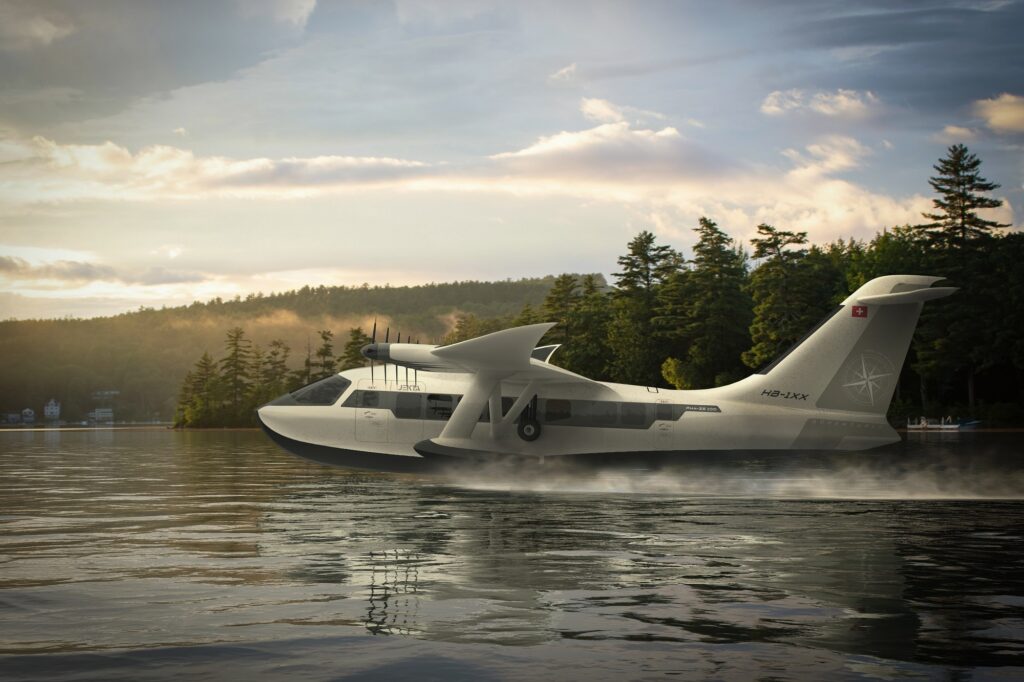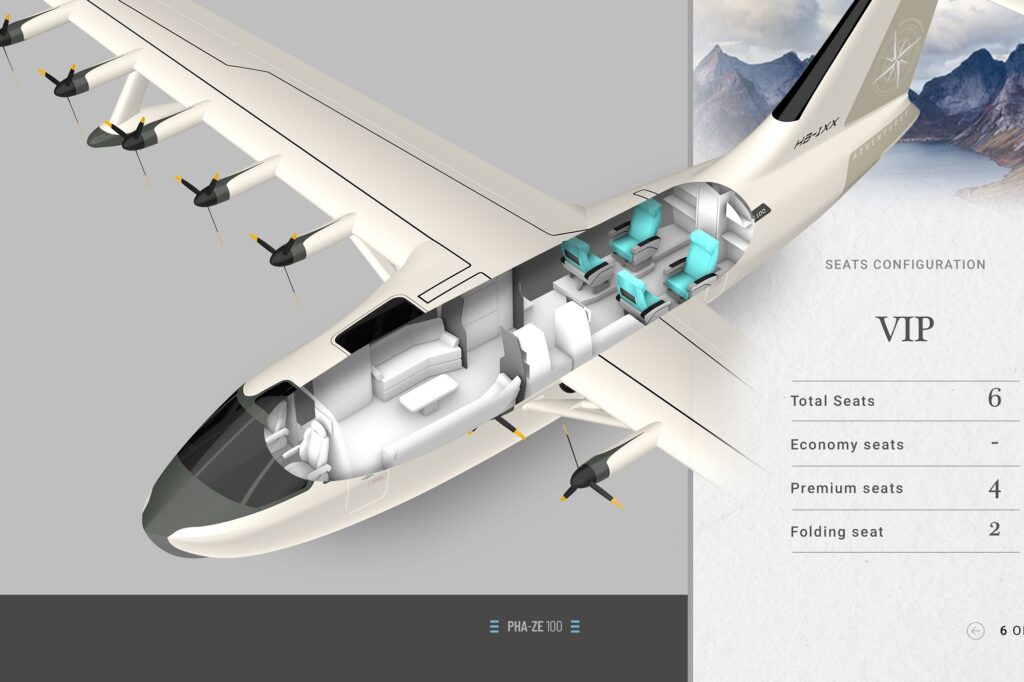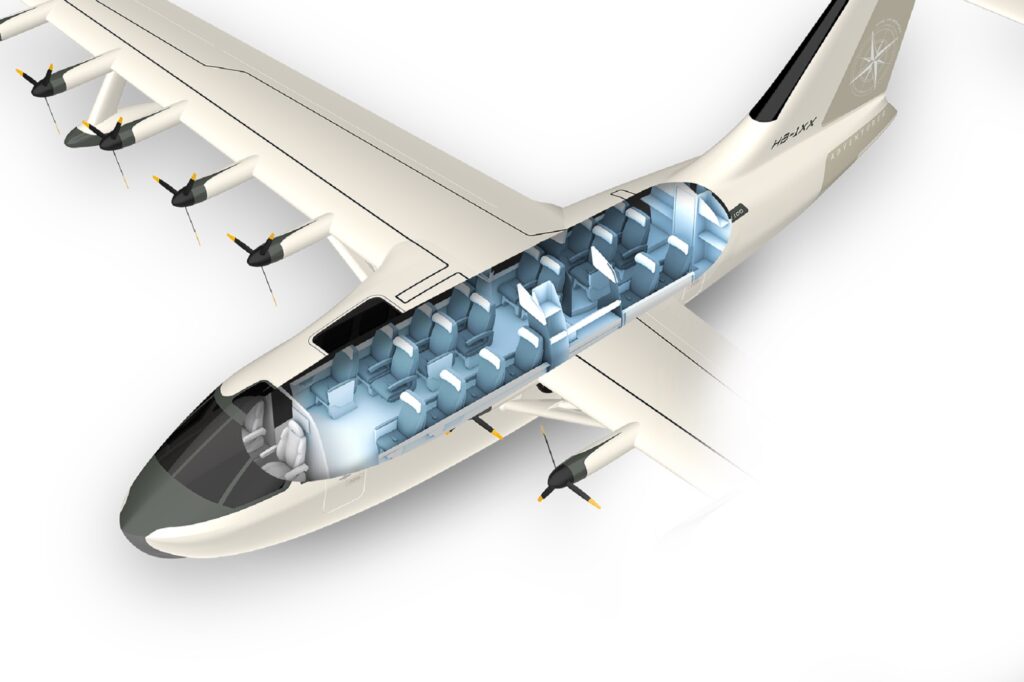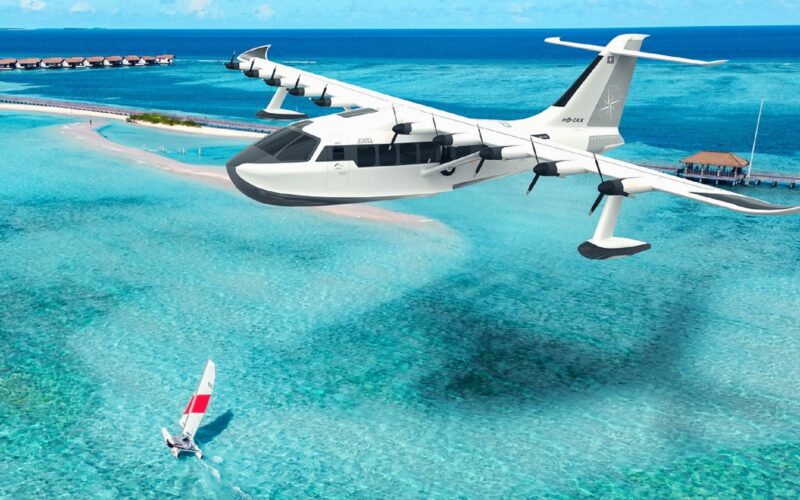Lauded as the next aviation revolution, startups across the world have shed blood, sweat and tears to bring electric vertical take-off and landing (eVTOLs) and Urban Air Mobility (AAM) aircraft to life.
But while the aviation industry obsesses over vertical take-offs and landings, in Switzerland a father and son duo have been planning their own aviation revolution.
And it is a movement that is gaining momentum and could open travel to the masses rather than delivering it for a few.
George Alafinov, CEO of hydroaircraft maker Jekta, and his father have 20 years’ worth of experience in the seaplane industry.
Aviation is in the family’s blood with the senior Alafinov even becoming the first pilot to circumvent the globe in an amphibian aircraft.
Since 2017, the family-run company has been putting all its efforts into a 19-seater electric-powered seaplane which would be the largest in existence.
39-year-old George Alafinov’s belief in the project is unshakable and his knowledge of the industry is watertight.
More importantly his vision and argument on why electric seaplanes represent a huge untapped potential after being neglected is compelling.
Aerotime spoke with George Alafinov in Apri, 2023, at Revolution.Aero in Dublin to learn more about Jekta.
AeroTime: So take us back to the beginning of the project. How did Jekta start?

George Alafinov: My father and I are the two co-founders of Jekta. For the last 20 years we have been designing, manufacturing and certifying amphibious aircraft.
We have two models; one is a two-seater ultralight and the other is an eight-seater twin engine.
In 2017 we had a meeting in India with the country’s government which was implementing a program of opening water routes for inter-regional travel.
Initially there were 70 routes and then this was extended to 94. The idea was to connect regions for the local population, transports services and goods, and the Indian government were looking at what was available on the market.
AT: What was the attraction of India?
GA: It was the potential for flight operators to emerge. The Indian government was interested in two things. First of all, the minimal investment required to open hydro bases. It’s not necessary to build runways or vertiports or whatnot.
And secondly, the minimum impact on the environment, because the water is already there, all you need to do is put in a pontoon and ramp, and there you have your base.
So, this is what pushed us to understand that there was a need for a much bigger amphibious aircraft, particularly a 19-seat aircraft.
When we looked at the market around the world, we found around 1,000 commercial seaplanes. All in traditional markets such as America, Canada, southern and northern Europe, the Maldives and Seychelles.
So, every single one of those operators are either flying a Twin Otter a Cessna Caravan. We’re talking about aircraft that were designed in 1967 and 1984.
They are land-based aircraft that have been adapted for seaplane operations, which brings additional weight and means the plane is not streamlined. They are also made from metal so require a lot of maintenance to prevent rust.
So, in general, the whole market is supplied with aircraft that are completely outdated in design, in the materials and are very, very costly.
AT: You felt that this was a part of the aviation industry that was neglected?

GA: It was an area that has been completely overlooked and neglected, and that creates enormous opportunities.
Originally, we began looking at building the 19-seater with combustion engines. Then during the COVID pandemic we started thinking what would happen if we made the aircraft electric.
What we discovered is that the decrease in operational and running costs are so significant that not only does it provide economic benefits for the existing operators, but it also actually provides for an emergence of operators in the areas that could not afford it before because the population could not afford to travel on the Twin Otter.
In India there is only one operator serving three of the 94 routes using a Twin Otter and what they realized is the local population cannot pay $200, £300 or $400 to travel on our flight. But when the seaplane is electrified, suddenly there’s a possibility to sell those tickets at $30 or $40.
So now we’re looking at India, where that is 1.4 billion people, and you have this incredible opportunity.
Additionally, we are also seeing an emerging South-East Asia, with an island chain between Thailand and Australia. That’s 700 million people who can potentially take a seaplane somewhere for $30 or $40.
This is why we strongly believe that the PHA-ZE 100 aircraft will allow for the emergence of new operators and airlines that serve thousands and thousands of passengers within India, South Central Asia, parts of Africa and of course, Brazil.
This is why we believe that as a first company, and we’re the only company that’s looking at the market of 19-seater aircraft, we have a tremendous opportunity not only to pierce this market and overtake the existing market but expand the market itself to new horizons.
Our advantage here is that Jekta has over 20 years of experience of building aircraft. We can leverage that knowledge; we can leverage that experience to simply expand and build a bigger aircraft. The critical point for us though is of course the electric propulsion system.
AT: Are you collaborating with other companies? Or working in partnership with other experts?

GA: Yes, we are collaborating, but we can’t say who is going to be our engine supplier just yet.
AT: Once the plane is up and running, how far will PHA-ZE 100 travel?
GA: With modern technology we are going to start with about 100 to 150 kilometers but, of course, with time and better technology the battery density improves.
This is why we’re implementing a system whereby our batteries are placed in the wing.
It’s a special container system where an operator or owner of an aircraft can take out those containers and change the batteries within them without changing the aircraft.
And therefore, as the technology advances, the aircraft’s endurance is going to improve without a big capital influx to the operator.
However, after conversations with hydrogen-electric aircraft developers there could be a solution where our planes could travel 400 or 500 kilometers from the get-go.
AT: Where will your first route be?
GA: Our first customer, Gayo Aviation, which signed up for 10 aircraft and the company is looking exactly at India.
Gayo Aviation plans to make the aircraft available for environmental and experiential tourism and charter operators wishing to bolster their sustainable transport options.
Gayo will also offer the aircraft on lease for scheduled affordable regional services in underserved communities.
Of course, the big one is transporting in airlines, and that’s 60 Twin Otters. Very, very costly.
AT: How wide does the body of water need to be to land?
GA: It is a bit early to say without testing. We can assume the take-off is going to be shorter than the landing.
It’s hard to say because first of all, at what point do you stop the landing? So, the take-off is a better metric for that, and we are striving for around 350 meters. That is our goal.
AT: With such high demand for pilots. who will fly your planes?
GA: All the commercial aircraft in this area must have two pilots. While our aircraft will be designed to be piloted by two pilots, it will be possible for one person to fly the plane.
This is why we have just signed an agreement with Honeywell to implement a system in development that will be robust and safe enough to be piloted by one person.
AT: Are you currently looking for investors that share your vision?
GA: We are looking for people who might be interested in this particular product.
It is a niche area that is completely overlooked. Right now, we are the first and the only company doing this.
The opportunity is enormous to completely overtake the market, become a global leader and expand.
AT: What are the next steps for Jekta?
GA: Well, there are several stages, the critical point is electrification, however we can use our own two-seater aircraft, of which there are around 40 across the world, in the development
We already have all the data, so we have the benchmark, then we install the battery, the propeller and control unit on this aircraft.
When we electrify this aircraft, any data we get is complete data because we have the benchmark.
If any other manufacturer goes to buy a Cessna, or whatever, they do not have a benchmark, they need to first fly 1,000 hours on combustion engine to gain that information.
We designed our aircraft from the start, it’s our baby, therefore we have all the information available.
AT: When do you think you will have the first prototype?
GA: I think we’re looking at the end of 2026. That’s just a prototype, because that’s when we’re going to have to build several of them.
We’ll then achieve the stage in our processes where we need to supply this aircraft to the Federal Office of Certification of Switzerland for testing.

